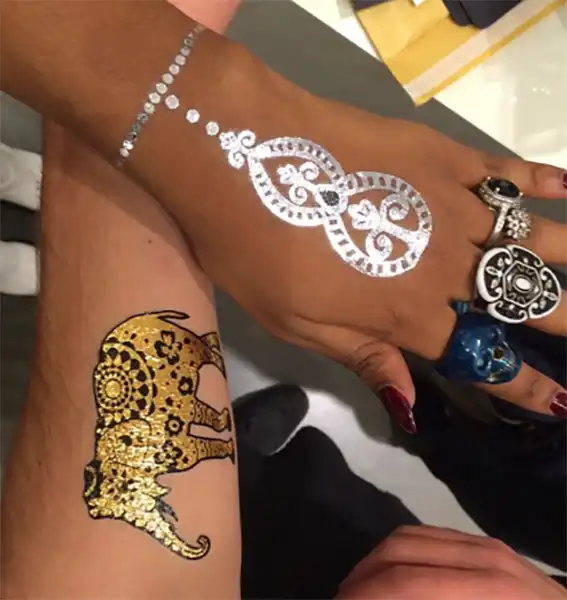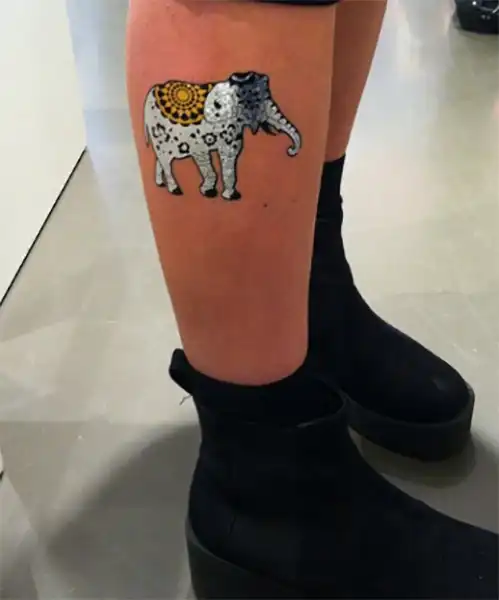Metallic Tattoos in Nairobi, Kenya
Metallic tattoos are temporary tattoos that mimic the appearance of metallic jewelry or body art. They are typically made with metallic pigments or foils and adhere to the skin temporarily, often lasting a few days to a week depending on factors like skin type and care. These tattoos gained popularity for their flashy and eye-catching designs, often featuring intricate patterns, symbols, or geometric shapes.

Metallic Tattoos
One of the advantages of metallic tattoos is that they offer a way to experiment with body art without the commitment of a permanent tattoo. They’re also versatile, coming in various designs and colors to suit different tastes and occasions. Metallic tattoos are often applied like traditional temporary tattoos, using water to transfer the design onto the skin, and they can be easily removed with oil-based products.
These tattoos have been embraced in fashion and culture, often seen at music festivals, beach parties, and other events where people want to add a touch of glam to their look. They provide a fun and temporary way to accessorize and express individual style.
Metallic Tattoos Process
The process of applying metallic tattoos is relatively simple and similar to that of traditional temporary tattoos. Here’s a basic outline of how it’s typically done:
- Clean the Skin: Start with clean, dry skin free from any oils or lotions. This will ensure better adhesion of the tattoo.
- Choose the Design: Select the metallic tattoo design you want to apply. Metallic tattoos come in various shapes, sizes, and designs, so pick one that suits your style and preference.
- Cut Out the Design: Carefully cut out the desired tattoo from the sheet, making sure to leave some space around the edges to avoid accidentally cutting into the design.
- Peel off the Plastic Sheet: Once you’ve cut out the tattoo, peel off the clear plastic sheet covering the design. Be gentle to avoid damaging the tattoo.
- Place the Tattoo: Position the metallic tattoo on the desired area of your skin. Once you’re satisfied with the placement, press it firmly onto your skin with the design facing down.
- Apply Water: Take a damp cloth or sponge and press it firmly against the back of the tattoo paper. Hold it in place for about 30 seconds to 1 minute, ensuring that the entire design gets thoroughly wet.
- Remove the Paper: Gently peel off the paper backing from the tattoo. If the tattoo hasn’t fully transferred, carefully place the paper back down and repeat the process.
- Allow it to Dry: Once the paper is removed, allow the metallic tattoo to air dry completely. Avoid touching or rubbing the tattoo during this time to prevent smudging.
- Optional Sealant (if provided): Some metallic tattoos come with a sealant to help extend their longevity. If included, you can apply the sealant over the tattoo according to the manufacturer’s instructions.
- Enjoy: Once the tattoo is dry, you’re ready to flaunt your metallic body art! Remember to avoid excessive rubbing or exposure to water to prolong its lifespan.
Removing metallic tattoos is usually easy and can be done with oil-based products like baby oil or makeup remover. Simply apply the oil to the tattoo, let it sit for a few minutes, and then gently rub it off with a cloth or cotton pad.
Metallic Tattoos Design Techniques
Designing metallic tattoos involves various techniques to create visually appealing and intricate patterns. Here are some common techniques used in creating metallic tattoo designs:
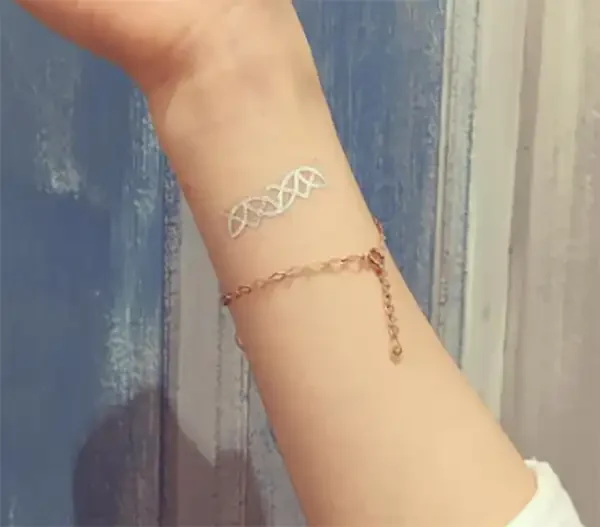
Geometric Patterns
Geometric shapes such as triangles, circles, squares, and hexagons are popular elements in metallic tattoo designs. These shapes can be arranged in repeating patterns or combined to create intricate geometric designs.
Floral and Botanical Elements
Floral motifs, leaves, vines, and other botanical elements are often incorporated into metallic tattoo designs to add a natural and organic feel. These elements can be stylized or realistic, depending on the desired aesthetic.
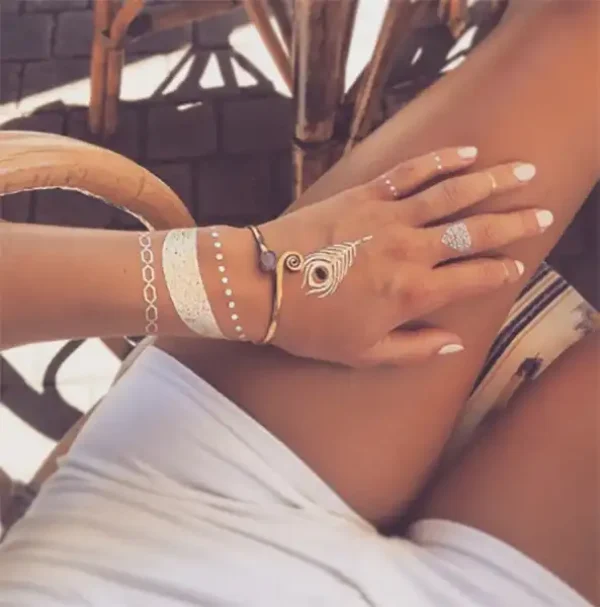
Animal and Wildlife Themes
Animal prints, silhouettes, and other wildlife-inspired designs can lend a bold and eye-catching look to metallic tattoos. Common motifs include animal prints like leopard spots or zebra stripes, as well as silhouettes of animals such as birds, butterflies, and wolves.
Mandala Designs
Mandala patterns, with their intricate circular and radial designs, are a popular choice for metallic tattoos. These symmetrical designs often feature geometric shapes, floral elements, and intricate detailing, creating a mesmerizing and spiritual aesthetic.
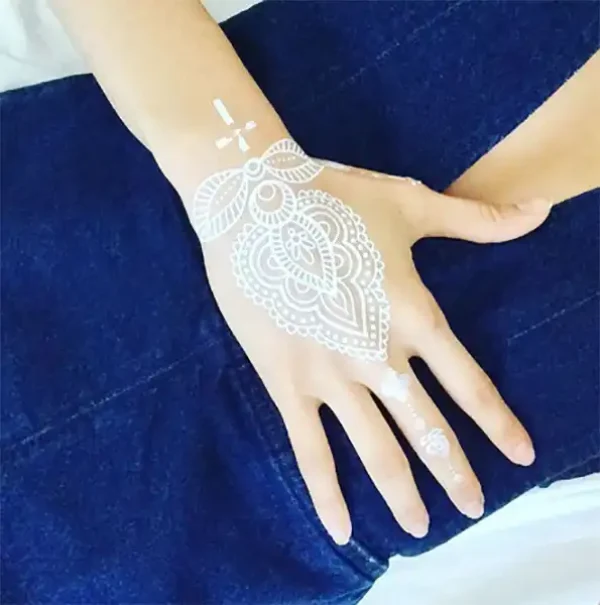


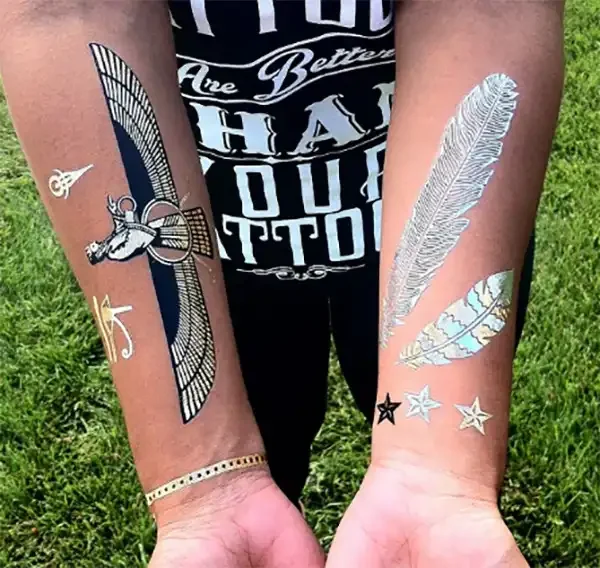


Tribal and Ethnic Motifs
Tribal patterns, inspired by indigenous cultures from around the world, are another common theme in metallic tattoo designs. These designs often feature bold lines, abstract shapes, and intricate patterns that reflect the cultural heritage of various indigenous peoples.
Typography and Text
Metallic tattoos can also incorporate typography and text, such as inspirational quotes, meaningful words, or personal mantras. The text can be stylized in various fonts and arrangements to create visually striking designs.
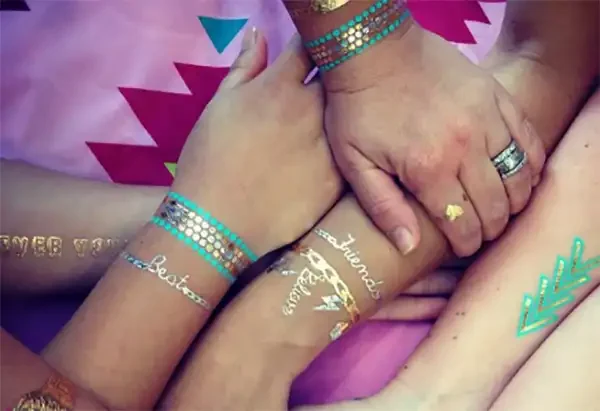


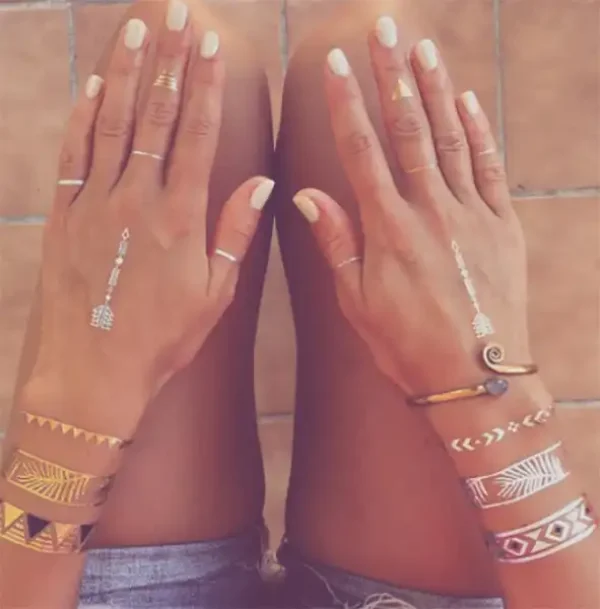


Abstract and Artistic Designs
Abstract shapes, swirls, splatters, and other artistic elements can be used to create unique and avant-garde metallic tattoo designs. These designs often rely on bold contrasts, dynamic compositions, and experimental techniques to make a statement.
Custom Designs
Many metallic tattoo artists offer custom design services, allowing clients to create personalized tattoos tailored to their individual preferences and tastes. Custom designs can incorporate elements such as initials, symbols, dates, or other meaningful imagery.
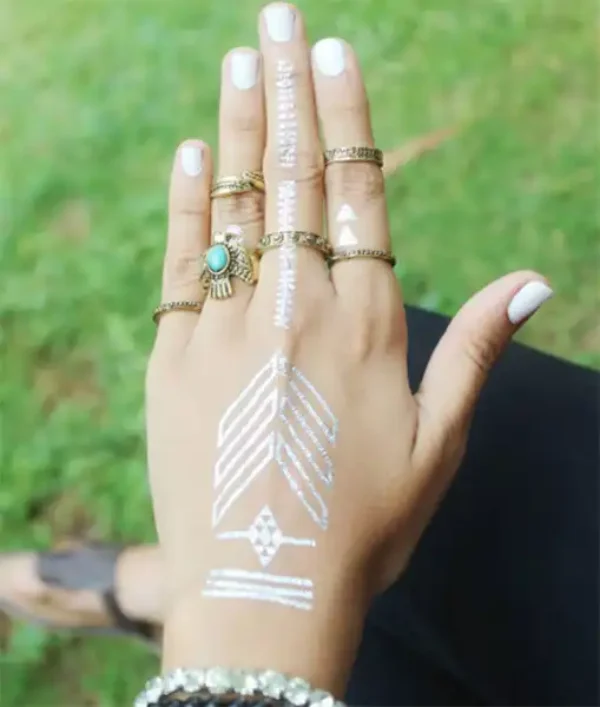


By combining these techniques and experimenting with different elements, colors, and compositions, tattoo artists can create a wide range of stunning metallic tattoo designs that cater to diverse tastes and styles. Whether you prefer bold and graphic patterns or delicate and intricate motifs, there’s a metallic tattoo design out there to suit your aesthetic preferences.
Schedule Appointment
Metallic Tattoos Placement
Placement of metallic tattoos can significantly impact their visual impact and longevity. Here are some popular and strategic areas for applying metallic tattoos:
- Wrists and Forearms: The wrists and forearms are prime locations for metallic tattoos, as they are easily visible and offer a flat surface for the tattoo to adhere to. Wristbands, cuffs, or bracelets created with metallic tattoos can accentuate your style and complement your accessories.
- Hands and Fingers: Metallic tattoos applied to the hands and fingers can create a striking and elegant look, especially for special occasions or events. Designs such as rings, intricate patterns, or symbols can enhance the beauty of your hands and add a touch of glamour.
- Shoulders and Upper Arms: Shoulder and upper arm placements provide a larger canvas for more elaborate metallic tattoo designs. These areas are often chosen for designs that wrap around the arm or shoulder, creating a cohesive and visually impactful look.
- Décolletage and Chest: Metallic tattoos applied to the décolletage and chest area can add a touch of shimmer and sophistication to low-cut tops or dresses. Designs that mimic jewelry or intricate necklaces can beautifully accentuate your neckline and enhance your overall look.
- Back and Spine: The back and spine offer a wide and relatively flat surface for larger metallic tattoo designs. These areas are ideal for statement-making designs such as intricate mandalas, floral motifs, or tribal patterns that span across the back.
- Ankles and Feet: Metallic tattoos applied to the ankles and feet can create a delicate and feminine look, especially when paired with sandals or open-toe shoes. Designs such as anklets, chains, or floral patterns can adorn your feet and add a touch of glamour to your footwear.
- Neck and Collarbone: Metallic tattoos applied to the neck and collarbone area can draw attention to these elegant and sensual areas of the body. Designs that frame the neckline or accentuate the collarbone can create a captivating and alluring look.
- Temporary Body Art: Metallic tattoos can also be applied to other parts of the body for temporary body art or costume purposes. From decorative accents on the face and hairline to embellishments on the legs or abdomen, the possibilities are endless for creative and expressive metallic tattoo placements.
When applying metallic tattoos, it’s essential to consider factors such as skin texture, movement, and exposure to friction or moisture to ensure the longevity and integrity of the design. Preparing the skin properly and choosing an appropriate placement can help maximize the visual impact and durability of your metallic tattoo.
Consideration when determining Metallic Tattoo Placement
When determining the placement of metallic tattoos, several considerations come into play to ensure both aesthetic appeal and practicality:
- Skin Texture and Surface: Choose areas of the body with relatively flat and smooth skin for optimal adhesion and longevity of the metallic tattoo. Avoid areas with excessive hair or prominent bony structures that may interfere with the application or cause the tattoo to peel off prematurely.
- Visibility and Impact: Consider the desired visibility and impact of the metallic tattoo. Select areas that are easily visible or commonly exposed, such as the arms, wrists, hands, shoulders, or décolletage, to showcase the design effectively and make a statement.
- Occasion and Clothing: Take into account the occasion and the type of clothing you’ll be wearing when deciding on the placement of metallic tattoos. Choose areas that complement your outfit and allow the tattoo to enhance your overall look without being obstructed or covered by clothing.
- Comfort and Movement: Consider the comfort and flexibility of the chosen placement, especially for areas that experience frequent movement or friction, such as the wrists, ankles, or waistline. Avoid placing metallic tattoos in areas that may rub against clothing or accessories, which could cause the tattoo to fade or peel off prematurely.
- Skin Sensitivity and Allergies: Be mindful of skin sensitivity and potential allergies when selecting the placement of metallic tattoos. Avoid areas of the body that are prone to irritation or allergic reactions, and conduct a patch test if you have concerns about specific materials or adhesives used in the tattoo.
- Longevity and Maintenance: Keep in mind that certain areas of the body may experience faster fading or wear of metallic tattoos due to factors such as friction, moisture, or exposure to sunlight. Choose areas where the tattoo is less likely to come into contact with water, sweat, or abrasive surfaces to prolong its longevity and vibrancy.
- Personal Preference and Style: Ultimately, the placement of metallic tattoos should reflect your personal preference and style. Consider areas of the body that you feel comfortable and confident showcasing, and choose placements that align with your aesthetic preferences and individuality.
Considering these factors, you can make informed decisions when determining the placement of metallic tattoos to ensure they not only look stunning but also stay intact and vibrant for as long as possible.
Metallic Tattoo Aftercare
Proper aftercare is essential to ensure the longevity and vibrancy of metallic tattoos. Here are some tips to care for your metallic tattoo after application:
- Avoid Water and Moisture: For the first few hours after application, avoid exposing the metallic tattoo to water or moisture. This allows the adhesive to set properly and prevents the tattoo from smudging or rubbing off prematurely.
- Be Gentle: Handle the metallic tattoo with care, especially during the initial hours after application. Avoid rubbing or scratching the tattoo, as this can cause the design to fade or peel off.
- Avoid Oily Substances: Refrain from applying oily or greasy substances such as lotions, creams, or sunscreen directly onto the metallic tattoo. These substances can weaken the adhesive and cause the tattoo to lift or lose its vibrancy.
- Protect from Friction: Be mindful of clothing or accessories that may rub against the metallic tattoo, especially in areas prone to friction such as the wrists, ankles, or waistline. Wearing loose-fitting clothing can help minimize friction and prolong the life of the tattoo.
- Limit Sun Exposure: Direct sunlight can cause metallic tattoos to fade or lose their luster over time. If possible, avoid prolonged exposure to sunlight or apply sunscreen over the tattoo to protect it from UV rays.
- Avoid Excessive Sweating: Perspiration can affect the adhesion of metallic tattoos and cause them to degrade more quickly. Avoid activities that may cause excessive sweating, or gently pat the tattoo dry with a clean cloth if it becomes damp.
- Gently Cleanse the Skin: When showering or bathing, be gentle around the metallic tattoo to avoid rubbing or scrubbing the design. Use mild soap and water to cleanse the skin, and pat the area dry with a towel instead of rubbing.
- Moisturize Carefully: After the metallic tattoo has fully set, you can moisturize the surrounding skin to keep it hydrated and healthy. Be cautious not to apply moisturizer directly onto the tattoo, as this can affect its longevity.
- Avoid Hot Baths or Saunas: Exposure to hot water or steam can cause metallic tattoos to degrade more quickly. Avoid soaking in hot baths or saunas, especially in the first few days after application.
- Remove Gently: When you’re ready to remove the metallic tattoo, use oil-based products such as baby oil or makeup remover to gently dissolve the adhesive. Apply the oil to the tattooed area and allow it to sit for a few minutes before gently wiping away the tattoo with a clean cloth.
Following these aftercare tips can help maintain the appearance and longevity of your metallic tattoo, allowing you to enjoy its beauty for as long as possible.
Factors that you should consider when getting a Metallic Tattoo
When considering getting a metallic tattoo, there are several factors you should take into account to ensure a positive experience and satisfactory outcome:
- Skin Sensitivity: Consider your skin sensitivity and any potential allergies you may have to the materials used in metallic tattoos. Test a small patch of skin with the tattoo adhesive or ink to check for any adverse reactions before applying the tattoo to a larger area.
- Design Choice: Choose a metallic tattoo design that reflects your personal style, preferences, and the occasion for which you intend to wear it. Consider factors such as size, complexity, and placement to ensure the design complements your overall look.
- Placement: Think carefully about where you want to place the metallic tattoo on your body. Consider factors such as visibility, comfort, and longevity when choosing the placement to ensure the tattoo stays intact and looks appealing for as long as possible.
- Skin Preparation: Prepare your skin properly before applying the metallic tattoo to ensure better adhesion and longevity. Cleanse the skin thoroughly and remove any oils or lotions that may interfere with the tattoo’s adherence.
- Application Technique: Pay attention to the application technique used for metallic tattoos to ensure a smooth and even application. Follow the instructions provided by the manufacturer or seek assistance from a professional tattoo artist if needed.
- Durability and Longevity: Consider the durability and longevity of the metallic tattoo, especially if you’re planning to wear it for an extended period or in situations where it may be exposed to water, friction, or sunlight. Opt for high-quality metallic tattoos that are designed to last longer.
- Temporary vs. Permanent: Decide whether you want a temporary or permanent metallic tattoo. Temporary metallic tattoos offer the flexibility to experiment with different designs without the long-term commitment, while permanent metallic tattoos require more careful consideration and commitment.
- Skin Tone: Take your skin tone into account when choosing metallic tattoo colors and designs. Some colors may appear more vibrant or flattering on certain skin tones, so consider how the tattoo will look against your skin color.
- Personal Comfort Level: Assess your personal comfort level with wearing metallic tattoos, especially if you’re trying them for the first time. Start with smaller designs or test patches before committing to larger or more elaborate tattoos.
- Removal Process: Consider the removal process for metallic tattoos and ensure you’re comfortable with the methods required to remove them when the time comes. Temporary metallic tattoos can typically be removed using oil-based products, while permanent metallic tattoos may require professional removal techniques.
Carefully considering these factors, you can make informed decisions when getting a metallic tattoo and ensure a positive and satisfying experience with your body art.
Metallic Tattoos Removal
Removing metallic tattoos is typically a straightforward process, especially for temporary tattoos. Here’s a general guide on how to remove metallic tattoos:
- Gather Supplies: You’ll need oil-based products such as baby oil, coconut oil, olive oil, or makeup remover, as well as cotton pads or soft cloths for removal.
- Apply Oil: Pour a small amount of oil onto a cotton pad or soft cloth. Gently dab the oil onto the metallic tattoo, ensuring the entire tattoo is covered with the oil.
- Let it Soak: Allow the oil to soak into the tattoo for a few minutes. This helps break down the adhesive and pigments, making it easier to remove the tattoo.
- Rub Gently: After letting the oil soak, gently rub the tattooed area with the cotton pad or soft cloth. Use circular motions to loosen the tattoo from the skin.
- Repeat if Necessary: If the tattoo doesn’t come off easily, repeat the process by applying more oil and gently rubbing the area until the tattoo is fully removed.
- Cleanse the Skin: Once the tattoo is removed, cleanse the skin with soap and water to remove any remaining oil residue.
Moisturize: After removing the tattoo, moisturize the skin with a gentle lotion or moisturizer to help soothe any irritation and keep the skin hydrated.
For permanent metallic tattoos, removal may require professional assistance from a tattoo removal specialist. Permanent tattoos are typically removed using laser therapy, which breaks down the ink particles in the skin over multiple sessions. It’s essential to consult with a qualified professional to discuss the best removal options based on your specific tattoo and skin type.
Overall, whether you have temporary or permanent metallic tattoos, it’s essential to approach the removal process gently and carefully to avoid irritating or damaging the skin.
Get In Touch
For more information on the list above and any other special services,please call or come in for free consultation
Testimonials
After he pierced my industrial piercing and seeing his amazing work, I feel even more excited about getting my tattoo with him in January. I’m really looking forward to it!
I am extremely happy with my new 'Safari' tattoo from Eric at Rebel Inks! The quality of the artwork is fantastic. Eric is a true professional and an amazing artist.
The preparation and design process was thorough and collaborative. He was very patient with my specific requests, including making sure all the elements, which hold personal meaning, were perfect.
The service was friendly and highly professional from start to finish. Despite the 8-hour session, Eric was a pleasant person to spend the time with.
The aftercare guidance and follow-up have been excellent and careful, which has made the healing process easy and better than expected.
I highly recommend Eric for anyone looking for a thoughtful, talented, and caring tattoo artist.
I recommend them 💯
I would definitely recommend if you’re thinking of getting a piercing!
The staff were super friendly, explained everything clearly, and made me feel so at ease. They answered all my nervous questions (and I had many questions),
They walked me through the whole process, gave detailed aftercare instructions, and even followed up afterward to check how I was healing 🫶
Clean, professional, and full of good vibes.
Would 100% recommend . Definitely making a second trip here.
This was the second tattoo I got and I wish I could have come to Eric for my first one! He gave me really great after-care directions for the tattoo as well as a little jar of his own Vaseline-type stuff to put over my tattoo while it was healing! He even put second skin over my tattoo so that I didn’t have to worry about it for the first few days. Now THAT’S good service. My first tattoo artist didn’t do none of that lol.
After the session Eric didn’t rush me and my friend out, he chatted with us and even when he found out I was an artist too— really encouraged me to keep creating and to find a community of artists to support me. I almost cried because I’ve had such a hard time with my own art the past couple of years, it meant so much to me to have a fellow very talented artist say that to me. 🤍🤍🤍
Eric you’re amazing, don’t ever stop creating and just know you’ve impacted lives all over the world!🫶🏻 thanks so much for everything!!
From the moment I walked in, Eric was professional, welcoming, and attentive. He made sure I was comfortable throughout, provided everything I needed, and explained every step of the process. The tattooing itself was unbelievably smooth - I genuinely felt no pain compared to my previous tattoos over the last 22 years.
Eric also gave me excellent aftercare guidance and products, and thanks to that, my tattoo healed beautifully. The attention to detail, precision, and shading are absolutely stunning. This is hands-down the best tattoo I've ever had, and I will be flying back to Nairobi for any future ink.
If you want incredible art, a professional experience, and a talented artist who truly cares about his clients, Rebel Ink is the place to go!
From start to finish, the service was exceptional. The piercer was professional, knowledgeable, and made me feel completely comfortable. The cleanliness of the place was above and beyond — everything was spotless and hygienic, which really put me at ease. Highly recommend for anyone considering a piercing!
Shout out to Eric😘
We ended up changing the jewelry three times to ensure I had the best fit and avoided any signs of rejection, and he always listened to my suggestions as a client, which I really appreciated. Now, three months in, my piercing is healing beautifully, with no sign of rejection. Highly recommend for anyone who values a piercer who cares about your comfort and healing journey!
What stood out the most was the aftercare Eric checked in with me even three weeks later to see how the tattoo was healing. That kind of follow-up shows how much he truly cares about his work and his clients.
I’m very satisfied and will definitely be coming back for my next piece. Highly recommend!
The piercing wasn't as painful as I had thought and the process was quick and satisfactory. I love it!!!
The piercing is healing well thanks to the aftercare instructions and follow-up. I would highly recommend Rebel Inks
Eric also did a belly button piercing for a friend, guiding her through the process, doing the piercing and then explaining the after care to her.
The shop is on the 3rd floor, with the entrance to the stairs near an alleyway on the left. The shop is perfect size, clean, and attractive looking. The mural is pretty dope.
Thank you for the amazing service! 🔥👅✨
I got piercibgs there and the process was really good. My biggest concern was hygiene but that wasn't an issue at all, they use new needles and they sanitize them.
The service itself was also welcoming.
I was informes of everything i needed to know beforehand.
10/10 would recommend!
Eric was so calm and patient with my almost 2 year old lady. It was such a clean and hygienic process. We will definitely be back for our second rounds of piercings and maybe even another tattoo!
They assess the area before any art and advise one accordingly. They also give one post clean up process and also do a check up after the body art projects. Overall, I loved my experience and I’m hooked. 👍
Will definitely come back next time I’m in town 🙂
He listened to what I actually wanted and made sure he could fit in the time before I flew back home.
The shop is clean & private and is easy enough to find.
Eric has even checked in a couple of times since to make sure all is good.
I would totally recommend Eric! I absolutely love my Elephants!
I had a very easy healing period and always follow up from Eric to check on my progress...I would highly recommend if you are a first timer because from my experience all went very well and attention to detail
Thank you for a good job and looking forward to send all my friends your way
And all the best with the new year 2025!
From the moment I walked in, the staff was super friendly and made me feel at ease. The studio had a clean, professional atmosphere, which immediately put me at ease. My piercer was incredibly skilled and explained every step of the process, ensuring I was comfortable the entire time. The piercing was quick and practically painless, and the aftercare instructions were clear and easy to follow. I can tell they really care about the health and safety of their clients.
Overall, a fantastic experience—I highly recommend Rebel Inks and Tattoos for anyone looking to get pierced or tattooed!
They do follow up after their services
Eric's Studio isn’t just a place to get a tattoo—it’s an experience. The combination of professionalism, artistic talent, and a welcoming environment makes it a standout destination for anyone considering a tattoo.
I highly recommend Eric’s Studio to both first-timers and seasoned tattoo enthusiasts. If you’re looking for a high-quality tattoo and an enjoyable experience, this is the place to go.
I would definitely recommend their services again and again
Thank you Rebel Ink
My piercings are healing ❤️🩹 well
I would 💯 recommend
I will definitely come back for more .
Two, all the equipments he used for the piercings were new and/or sterilised.
Three, the parlour itself was very clean and was up to par with the hygiene standards.
Four, Eric provided effective aftercare instructions, making sure I knew exactly how to take care of my new piercings and he kept in touch and continues to do so, to check on the healing progress.
I highly highly highly recommend this place!!!
Would definitely recommend them to friends and go back for other piercings
Not only was the piercing process smooth, but he also provided thorough aftercare instructions, making sure I knew exactly how to take care of my new piercings. What really impressed me was that he keeps in touch to check on how the healing is progressing – a sign of true care for his clients.
The shop maintains a high standard of hygiene, and the atmosphere is welcoming and comfortable, which really added to the positive experience. I highly recommend this place to anyone looking for a professional and caring experience. I’ll definitely be coming back for any future piercings!
My appreciation for the excellent customer service I received. The follow-ups were prompt, and I truly appreciated the gentleness and professionalism throughout. Thank you!"
"Looking for professional eyebrow microshading removal? Look no further!"
The customer care is top tier 👌🏾👌🏾.
Wonderful place to get tattoos and piercings. 💯💯
Eric goes ahead to follow up on his clients progress and gives good advice each time I reach out to him.
I would recommend Reble tattoos anytime.
Good job bro we really appreciate.
Ohh and the price is very fair.
The environment was clean , procedure was sterile and the jewelry used are of the best quality.
He followed up with me during the healing process, he educated me on what I needed to do for my aftercare.
Eric is confident, skilled , experienced and the best piercer. Highly recommend Rebel inks.✨
Definitely recommend!
Great experience.
Eric definitely know what he is doing .
I got exactly what I wanted 2 tiny tats on the same finger .
He was kind and patient throughout the session.
Healing process has been good .
Aftercare services were given and regular checkups on the healing process were done.
I would 💯recommend.
Eric gave me the best reception as it was my first time there,and made me trust him all the way. I appreciate good services.
There services are also affordable not to forget 😊.
He was also invested in the aftercare and would ensure I follow the do's and don'ts in taking care of the tattoo and ensuring proper healing and maximum ink retention.
Would highly recommend Rebel Inks Tattoos.
Rebel Inks Tattoo offer the best,affordable and quality tattoo removal services.If you have unwanted ink,choose Rebel Inks Tattoo,they're the best of the best and the professionalism is a top notch.They ensure you're free from unwanted ink with their Laser Tattoo Removal Technology...
I did a Laser Tattoo Removal with them and i can attest they're the best....
Kudos Eric...
I highly recommend.
It was a generally good experience with good hygiene during the piercing process and has been a smooth healing process.... 10/10
tips. Highly recommend 👍🏽
100% recommendable.
I was particularly impressed with Eric's attention to hygiene. He thoroughly cleaned the room before I entered, sanitized all of the equipment he would be using, and changed gloves between each ear. This level of cleanliness gave me great confidence in his professionalism.
Eric's commitment to customer service did not end on the day of the piercing. He followed up with me regularly throughout the healing process to ensure that I was following the aftercare instructions and that my earlobes were healing properly.
I highly recommend Rebel Inks to anyone in Nairobi who is considering getting a piercing. Eric is a highly skilled and experienced piercer who takes great pride in his work.
So I Check all the boxes below and more:
Customer Care: ✔️
Professionalism : ✔️
Cleanliness ✔️
Price: ✔️
After care service ✔️
Thanks and good job, Eric
The place is neat and clean and the equipments he used were also fine standards. Really appreciate his following up with me on the healing 🤗
I WOULD HIGHLY RECOMMEND THEIR SERVICES to everyone. Actually what you see on their website is EXACTLY what you will get. Keep up the good work Rebel inks Tattoos.
The infection is now gone. I would definitely recommend!
Can recommend this place totally and would go back there anytime!
Thanks!
OUR LOCATION
Areas We Serve
NAIROBI
KIAMBU
KAJIADO
MACHAKOS

